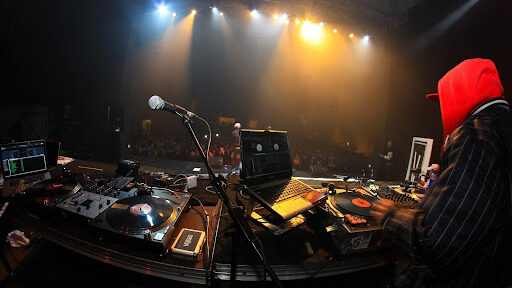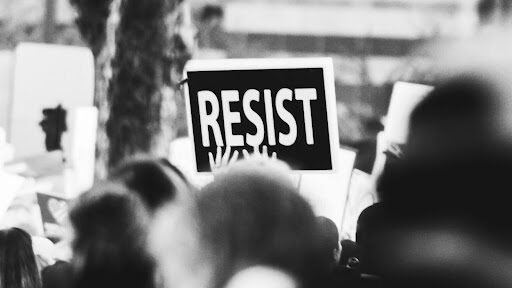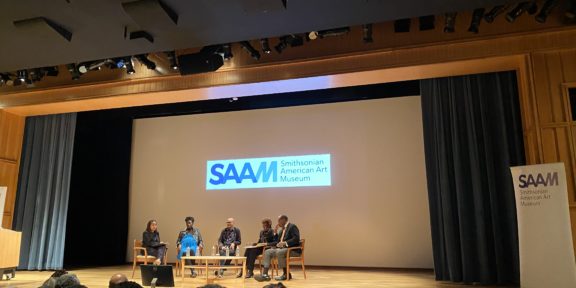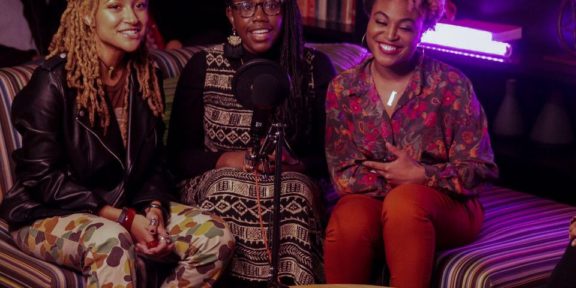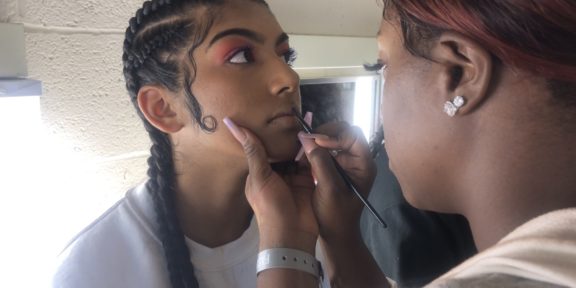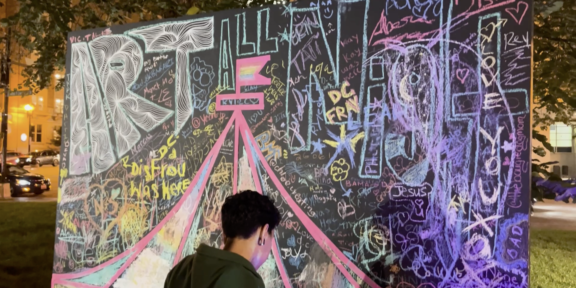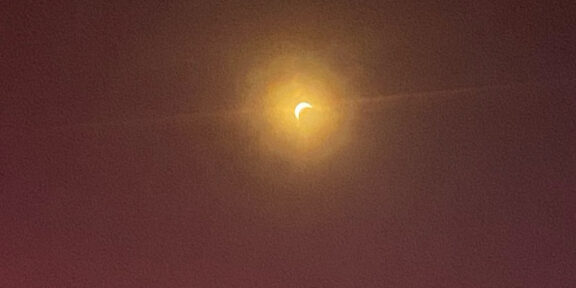With a Latin funk-infused rhythmic sound, go-go music has filled the streets of D.C. since the early 1970s. In 2023, the sounds might be heard from the Metro PCS on Chuck Brown Way– named in honor of “The Godfather of Go-Go” – or blasting from the speakers of someone’s car, but in the 70s and 80s, D.C. natives of all ages could go to the go-go and hear live bands for less than $5.
As a sound, go-go is known for its call-and-response structure and for its ability to keep people moving on the dance floor. But as an experience, go-go is a cultural landmark that continues to bind city natives and new residents alike to the legacy of “Chocolate City”.
The origins of go-go are often attributed to Gaston, North Carolina native Chuck Brown and his band The Soul Searchers, who popularized a more relaxed, funk-infused sound with elements of Latin rhythms, according to The Beat Is Go-Go. Bands such as Rare Essence, Experience Unlimited (EU) and Trouble Funk began adopting a similar model, leading to what Natalie Hopkinson, Ph.D. refers to as the “first wave of go-go.”
Bustin’ Loose – Chuck Brown & The Soul Searchers
“That first generation was a very upbeat, kind of ‘big band’ sound [with] multilayered horns and percussion. Their sound was deeply influenced by rock and funk but they added the Afro-Latin rhythms,” Hopkinson, an associate professor at American University, said. “It’s sort of like a sunny, happy, big, loud, full sound.”
A journalist and go-go scholar, Hopkinson first took an interest in go-go while working as arts writer and youth culture writer at the Washington Post. She eventually left The Post to pursue a Ph.D. at the University of Maryland College Park and chose go-go as her dissertation topic. She later released a book, “Go-Go Live: The Musical Life and Death of a Chocolate City” in 2012.
Despite the rampant nature of gentrification in D.C. and the title of her book, she now believes that Chocolate City is far from dead thanks to the Black people still creating culture in the District– including those who still create and recognize go-go music.
“I think it’s important to claim the space culturally and politically and [not] concede anything,” Hopkinson said. “Go-go is a story that goes in circles … it just never stops.”
For those who came up attending the live shows during the “first-wave,” go-go was more than a sound, but rather an experience that cannot be replicated. Ericka Blount, an award-winning journalist and lecturer at Howard University, most enjoyed the community-oriented aspect of go-go shows.
“That time period was a time capsule because we were getting live music from really gifted musicians, many of whom had played with jazz musicians, and we were just able to have a good time,” Blount said.
The next wave of go-go, which took place in the 90s, saw influences from hip-hop with groups such as Junkyard Band and Northeast Groovers developing a “gangster go-go” sound, pulling from the same themes as gangster rappers. After that came the “grown and sexy” era of go-go, which took place during the 2000s.
“This is when go-go really kind of went a little bit underground because of all the violence from the 80s and 90s around the crack trade– go-go had been blamed for it and criminalized, so they kind of had to mellow it out,” Hopkinson said. “They start with a kind of funk, [or] a real R&B sound. But as the night goes on … it really cranks up with the rototoms,” which are shell-less drums that can change pitch.
With All My Heart – Junkyard Band
The last wave to emerge, “bounce beat,” is more percussive, taking on a more energetic sound. Through this wave came “Alphabet Bands” such as TCB, or Total Control Band and CCB, or Critical Condition Band.
“The dancing is really aggressive and that’s where the ‘Beat Your Feet’ movement, which came out of a song by TCB, entered into the chat,” Hopkinson said. “It’s less traditional as far as what the music goes, but as Chris Richards, who is the Pop Music critic for the Washington Post, said, it’s a sound that is invented.”
Beat Your Feet Cypher – 2019
Kevin “Kato” Hammond, a musician and owner of Take Me Out to the Go-Go Inc., believes that modern-day go-go is less instrumental now than it was in its early days, which can be attributed to digital innovations.
“Your average go-go band was between nine and 13 people, and they all played– you don’t really need that today,” said Hammond, the frontrunner of Kato and the Allycats. “Bands aren’t as prevalent today as they used to be back then. You can make a whole song in your bedroom.”
Having served as a lead vocalist and guitarist for bands such as Pure Elegance and Proper Utensils, he remembers when playing in a band was “the thing to do in D.C.” One thing that he enjoys most about go-go is the improvisational aspect.
“You can be playing the same songs, but the shows are always different. It’s all based on audience reaction,” Hammon said. “If you’re playing a song and it isn’t working, you can tell and you can get out of that song quickly.”
Audiences were a huge part of the traditional go-go experience. Not only would audience reactions inform what songs were played, but people in the crowd could even walk up to the stage and interact with the musicians.
“It was almost like they were walking to the altar,” Blount said. “That element was a very Black experience … I think that element is gone now.”
The changes to the go-go experience are seen as a natural evolution for any musical genre in an ever-changing music industry.
“I think the music industry is at the foundation of a lot of how we see music– how it’s changed, how it’s been changing over the course of several decades,” Blount said. “I think in the same way that other forms of music have sort of been ‘cookie cutter,’ go-go got into that same realm.”
Yet, younger generations are still well-aware of how important go-go is to D.C. culture. Alana McClellan, a TV and Film major at Howard and D.C. native, says that go-go was a huge part of her upbringing.
“Go-go music was an essential in my household, among the classic hip-hop and R&B music,” McClellan said. “It was also a part of my parent’s upbringing. They grew up on Chuck Brown and always went to the ‘go-go’ to see the go-go bands and live music.”
Like Blount, she enjoys how the sound and experience breed a sense of community.
“It brings people together,” McClellan said. “You immediately want to dance and everyone has a good time.”
As D.C. continues to undergo changes, some are worried about where the culture– including go-go– and the legacy of Chocolate City fares. However, a number of entities continue the fight to preserve these things.
Don’t Mute DC is one of these movements. It initially started as a hashtag made by Julien Broomfield, who was a senior at Howard University, in 2019. At that point, a disgruntled newcomer to the Howard-Shaw area forced the Metro PCS on Chuck Brown Way to close down, as they did not like how the store would continuously blast go-go.
Ronald Moten, a peace activist, and Hopkinson started a petition that gained over 80,000 signatures in order to get the music turned back on. Successful in doing so, the movement continued to do more work.
“There was so much pent-up frustration around gentrification, Black erasure, all this stuff in the streets that we just kept going,” Hopkinson said. “We won more victories. We activated the music around healthcare, schools, jobs, mass incarceration and getting this ‘official music’ status.”
Thanks to the work of Don’t Mute DC and other activists, Mayor Bowser signed a bill that designated go-go as the official music of D.C. in 2020. Now, Hopkinson and Moten are working to establish a go-go museum, which will be located in the Anacostia area of Southeast D.C.
While go-go and the District have certainly seen changes since the 70s, the legacy of Chocolate City remains alive and well thanks to those who work hard to preserve the culture.
“It was a unifying form of music,” Blount said. “It was something that everybody in the city could appreciate and enjoy. I think preserving that culture is a key part of preserving D.C. and D.C. history.”
Preservation starts with inclusion and recognition of the genre’s significance.
“[Go-go] is the soundtrack of a culture,” Hammond said. “It’s straight ‘feels’. And when you’re feeling it, it doesn’t matter what’s right.”
Cory Utsey is a reporter for HUNewsService.com and covers music.

